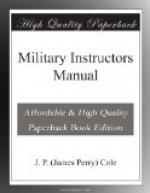2. AREA SKETCH.—A map of a definite locality. There are 3 kinds of area sketches according to opportunity for observation:
(a) Position Sketch—when
access may be had to the whole area.
(b) Outpost Sketch—where
part of the ground must be mapped without
passing
over it. This form is applicable particularly
to trench
warfare.
Intersection and resection are used to locate points
within the
enemy’s lines.
(c) Place Sketch—when
sketch must be made from one point, as when
the proximity
of the enemy would prevent any movement; as from
trench observation
stations, etc.; also an elaboration of the
landscape
or horizon sketch which is used everywhere in
the
trenches
today. From one point an actual outline of the
opposite
trench and background is made in perspective,
reference
points on the horizon being marked on the edge of a
pad at arm’s
length. These marks are then prolonged on the
paper and
the horizon is sketched. In like manner the middle
distance
and the foreground come under observation and are put
on in one
below the other.
Time must be allowed the men to make their stride scales and to paste or transfer them to their alidades.
[Illustration: Plate #9]
LESSON 3. (FIELD WORK—FIVE HOURS.)
The problem is to make a Position Sketch about one mile square closing the traverse. First considering the sketch board, compass, pencils, etc.; next the orienting, sighting and pacing; finally the uses of intersection and resection and in making allowance for error.
The sketch board should be about 12 to 18 inches square, being used with or without a tripod. A cheap camera tripod is excellent. The board should have a compass attached so that it will remain in the same relative position on the board. If iron thumb tacks are used avoid getting them too near the compass. A hard pencil must be used to obtain good results. The paper must be smooth and where possible covered with another sheet fastened on but one side which will readily fold back when one desires to work on the sketch.
By always placing the board so that the compass reads North it will be oriented correctly. Care must be used when near electric wires or masses of metal as automobiles, railroad tracks, etc., which will attract the needle from its true azimuth (N. and S. direction) and thus throw off the whole map. In such cases it is far better to back sight and use the compass only at intervals to verify the sights.
This brings up the matter of sighting. It is important to make long shots thus reducing the amount of individual error. In taking a sighting point make sure it can be recognized when reached and make sure to look at the reverse side in order to recognize it in case of back sighting if necessary. Always carry several large-headed pins using one at your present station and resting the side of the alidade against it, swinging the other end for sighting.




